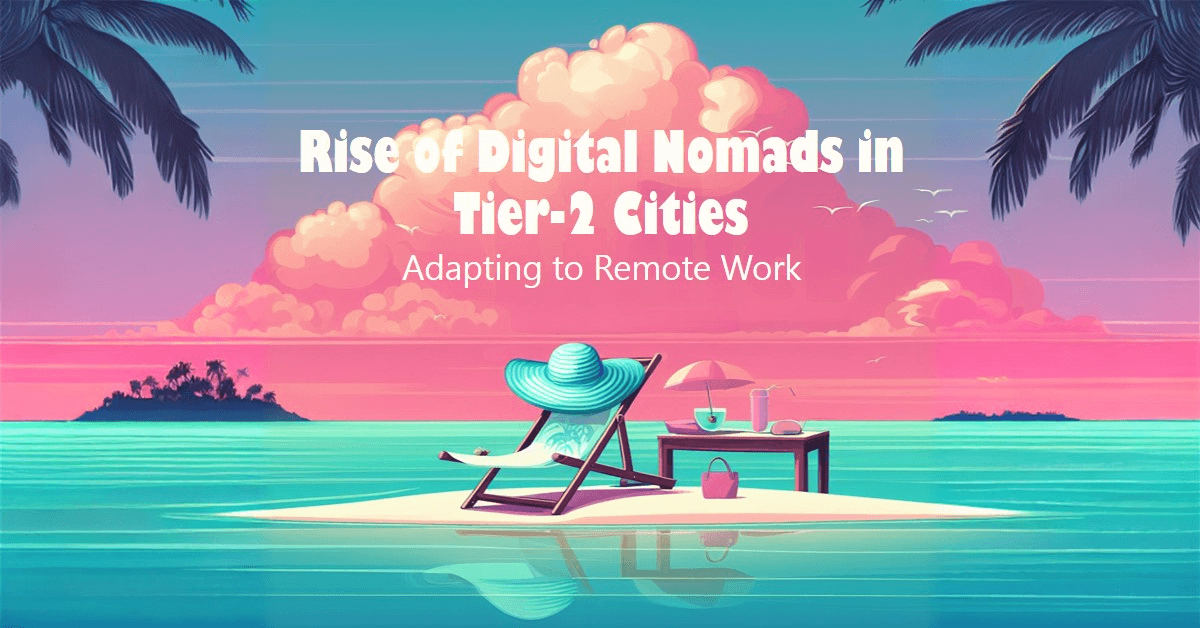As the world embraces remote work, a new trend is emerging in India: the rise of digital nomads in Tier-2 cities. Once considered secondary to the country’s major metropolitan hubs, smaller cities like Jaipur, Coimbatore, Indore, and Chandigarh are fast becoming attractive destinations for remote workers. This shift is driven by a combination of affordable living, thriving co-working spaces, and an improved quality of life.
In this article, we’ll explore the rise of digital nomads in Tier-2 cities, the economic and social advantages these cities offer, and how they’re evolving to meet the demands of a new class of remote workers.
The Digital Nomad Lifestyle and Why It’s Growing in India
The digital nomad lifestyle is built on the idea that work can be done from anywhere, thanks to the power of the internet and the flexibility offered by remote jobs. Whether you’re a freelancer, entrepreneur, or full-time employee, working remotely offers unprecedented freedom to choose where you live and work.
While large Indian cities like Bangalore, Mumbai, and Delhi have traditionally been hubs for remote workers, the high cost of living, traffic congestion, and hectic lifestyles in these cities are driving a growing number of remote professionals to seek more affordable, peaceful, and community-driven environments in Tier-2 cities.
Why Digital Nomads Are Choosing Tier-2 Cities
1. Cost of Living Advantages
One of the most significant factors driving digital nomads to Tier-2 cities is the lower cost of living. Rent, food, and transportation costs in Tier-2 cities are significantly lower than in metro areas. For instance, in Indore, a one-bedroom apartment in the city center can cost as little as ₹10,000 per month, compared to ₹40,000 or more in Bangalore or Mumbai.
In smaller cities, remote workers can stretch their income further, affording a higher standard of living. Whether you’re looking for a modern apartment or a peaceful home in the suburbs, Tier-2 cities offer a variety of affordable housing options. For digital nomads who thrive on travel, these savings allow them to allocate more funds for experiences, entertainment, and travel.
2. Coworking Spaces: A Growing Ecosystem
Coworking spaces have been instrumental in supporting the rise of digital nomads, offering a collaborative work environment and a sense of community. In recent years, Tier-2 cities have seen a surge in coworking spaces designed to cater to remote professionals.
Cities like Jaipur and Chandigarh now boast modern coworking facilities with high-speed internet, meeting rooms, and flexible membership plans. For instance, Workstreet in Jaipur offers a vibrant coworking atmosphere with prices starting as low as ₹5,000 per month. Similarly, CoWrks in Coimbatore offers a professional yet community-driven space, ideal for freelancers, startups, and remote teams.
Coworking spaces in these smaller cities provide more than just a desk and Wi-Fi—they offer networking opportunities, professional development events, and social gatherings. This sense of community is crucial for digital nomads who often face the challenge of isolation when working remotely.
3. Improved Quality of Life
Unlike their metro counterparts, Tier-2 cities provide a more balanced and relaxed lifestyle. Reduced traffic congestion, cleaner air, and a slower pace of life are attractive to digital nomads who want to escape the hustle and bustle of larger cities.
For instance, Chandigarh is known for its wide, green spaces and excellent urban planning, making it a perfect place for remote workers who value outdoor activities and a cleaner environment. Similarly, Mysore offers a slower pace of life with access to cultural experiences, yoga retreats, and proximity to natural beauty, all while offering the modern amenities that digital nomads need.
4. Cultural and Travel Opportunities
Tier-2 cities in India are often rich in history, culture, and natural beauty, providing a wealth of experiences for digital nomads. For instance, Jaipur offers the opportunity to explore historical forts and palaces while being a vibrant, creative hub. Meanwhile, Coimbatore is known for its proximity to hill stations like Ooty and Coonoor, making it easy for remote workers to balance work with leisure travel.
The relatively low cost of living and the flexibility of remote work also allow digital nomads to take advantage of nearby travel destinations, turning weekends into mini-vacations.
How Tier-2 Cities Are Adapting to the Digital Nomad Trend
Recognizing the potential of attracting digital nomads, Tier-2 cities are evolving rapidly. Local governments and businesses are investing in infrastructure, technology, and amenities to make their cities more appealing to this growing demographic.
1. Improved Infrastructure
Many Tier-2 cities are investing in better infrastructure to support the digital workforce. Reliable internet connectivity is a must for digital nomads, and cities like Indore and Jaipur are improving access to high-speed broadband in both urban and suburban areas. Improved transportation networks, including airports and public transport, make it easier for remote workers to travel to and from these cities.
2. Local Government Initiatives
Some cities have implemented policies to attract entrepreneurs and remote workers. Startup India, a government initiative, has created an ecosystem where smaller cities can become tech and innovation hubs. These initiatives offer financial incentives, simplified regulations, and co-working space subsidies that benefit digital nomads and startups alike.
The Smart Cities Mission is another example of how the government is transforming smaller cities into modern urban centers. This initiative focuses on improving infrastructure, enhancing digital services, and creating more sustainable and livable environments in Tier-2 cities across India.
3. Affordable and Diverse Housing
Housing developers in Tier-2 cities are catering to digital nomads by building affordable, modern homes that appeal to remote professionals. Coliving spaces are also on the rise, providing shared living environments where digital nomads can work, live, and connect with like-minded individuals.
Future of Digital Nomadism in India’s Tier-2 Cities
The rise of digital nomadism in Tier-2 cities is not just a passing trend—it’s a paradigm shift in the way people live and work. With the continued growth of remote work and the increasing popularity of smaller cities, this trend is likely to expand in the coming years. As more cities recognize the value of attracting digital nomads, we can expect to see further investments in infrastructure, coworking spaces, and community-driven initiatives.
As businesses and startups become more remote-friendly, the digital nomad lifestyle will become an appealing option for a broader range of professionals. Whether you’re a freelancer, entrepreneur, or full-time remote worker, the opportunities in Tier-2 cities are vast.
If you’re interested in more trends in remote work and urban innovation, check out our article on Remote Work Productivity Tips and explore how India’s Smart Cities Mission is transforming smaller cities into digital hubs.
External Links:
- Smart Cities Mission: Learn more about India’s Smart Cities initiative and how it’s improving urban living.
- Startup India: Discover how the Startup India initiative is creating opportunities in Tier-2 cities.
As Tier-2 cities continue to adapt to the needs of digital nomads, they are proving that smaller doesn’t mean less. These cities offer a blend of affordability, convenience, and quality of life that is becoming increasingly hard to find in major metros. The future of work in India may very well be written in the streets of its Tier-2 cities.










